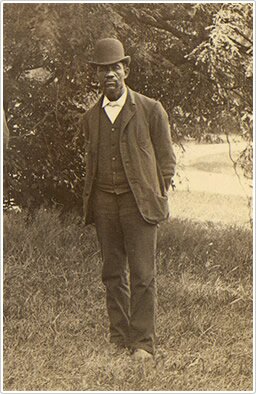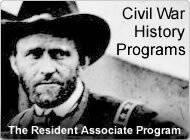
"Man of Mark," Solomon G. Brown
The Smithsonian Associates Civil War E-Mail Newsletter, Volume 7, Number 4
In the latter part of the 19th Century, Reverend William J. Simmons compiled a book of biographies of prominent African Americans. He did it because he was concerned that former slaves, their children, and their children's children would grow up ignorant of the remarkable African Americans who contributed to their race and their nation. He did it so that their stories would inspire them to overcome their own hardships and the social and psychological impact 200 years of slavery had wrought on their society.
Names like Frederick Douglass, Crispus Attucks, and Benjamin Bannecker are familiar to some Americans, but most are not. Among the least known of these "Men of Mark: Eminent, Progressive and Rising," is Solomon G. Brown.
Most of the individuals highlighted in Simmons' book were born into slavery, but Solomon Brown was not. He was born of free parents in the District of Columbia. However, like almost all the individuals in the book, Brown was born poor and grew up illiterate. By 1844, at age 15, he was homeless and penniless, but managed to find work with the assistant postmaster in Washington. Besides delivering the mail, the post office department at that time had oversight for a new experiment conducted by the esteemed scientist Joseph Henry and partners.
 Henry's primary partner was Samuel F. B. Morse, whose goal was to convince the government that a mechanical telegraph could accurately and quickly send messages across the entire country. To test the feasibility of the telegraph, they needed manual labor to construct the poles and install the wires. Beginning from Washington to Baltimore, Solomon Brown was assigned to help, becoming the only African American to witness first-hand the birth of the telegraph age.
Henry's primary partner was Samuel F. B. Morse, whose goal was to convince the government that a mechanical telegraph could accurately and quickly send messages across the entire country. To test the feasibility of the telegraph, they needed manual labor to construct the poles and install the wires. Beginning from Washington to Baltimore, Solomon Brown was assigned to help, becoming the only African American to witness first-hand the birth of the telegraph age.
While Morse's future held a lifetime of lawsuits and financial distresses, Joseph Henry's future was bright. Soon after the telegraph experiment, Henry was named the first Secretary of the newly established Smithsonian Institution. And, very soon after that he hired Solomon Brown to work as a laborer.
Brown didn't stay a laborer for long. He quickly became indispensable to the Institution by teaching himself to read, and with time, acquiring the skills in chemistry, math, and science necessary to pursue studies in nature and biology. Brown eventually became a noted naturalist, renown for his witty, self-illustrated lectures on geology, plants, and insects. His life outside the walls of the Smithsonian were just as noteworthy. Brown was elected to the D.C. House of Delegates; he founded several schools and churches the new African American communities of post-Civil War Washington; and, he was an accomplished poet. In 1904, Solomon Brown was present at the groundbreaking of the first national museum, the Smithsonian's National Museum of Natural History. He retired from the Smithsonian two years later, after 54 years of dedicated service.
Solomon G. Brown earned his position in Reverend Simmons' book of esteemed African Americans, as he was an inspiration to all who knew him, and his story will inspire those who read about him. By doing so, he also personified the Smithsonian's mission by devoting his life to "the increase and diffusion of knowledge."

